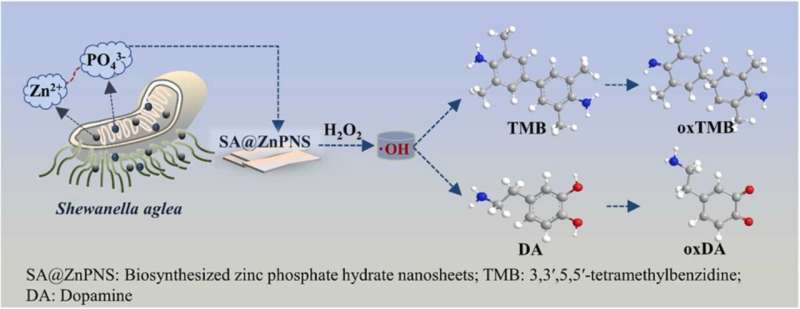This article has been reviewed according to Science X's editorial process and policies. Editors have highlighted the following attributes while ensuring the content's credibility:
fact-checked
trusted source
proofread
Using peroxidase-like phosphate hydrate nanosheets for highly sensitive dopamine detection

Marine microorganisms are considered as one of the most active parts in marine ecosystems. Utilizing marine microbial resources has become a key point in marine biotechnology. The biosynthesis of functional nanoparticles with the regulation of marine microorganisms has especially attracted much attention.
Recently, a research team led by Assoc. Prof. Zhai Xiaofan from the Institute of Oceanology of the Chinese Academy of Sciences (IOCAS), cooperating with Prof. Tang Xuexi from Ocean University of China (OUC), reported a colorimetric sensor based on zinc phosphate hydrate nanosheets (SA@ZnPNS).
The study was published in Colloids and Surfaces B: Biointerfaces on March 6.
The researchers proposed a novel biosynthesis strategy of SA@ZnPNS using Shewanella algae, which was efficient, environmentally friendly, and low cost. SA@ZnPNS was characterized and optimized by two important parameters of pH value and precursors concentration. SA@ZnPNS showed an excellent peroxidase-like activity which can catalyze H2O2 to ·OH and then turn 3,3,'5,5'-tetramethylbenzidine (TMB) to oxidation state, causing a color variation to blue.
Based on the properties of SA@ZnPNS, a fast colorimetric method for dopamine (DA) quantitative analysis was proposed. The detection mechanism was clarified as DA consumed quantified ·OH and caused a lightened blue color of reaction system. The linear range of DA detection was 0.1–40 μM, and detection limit was 0.083 μM. "The colorimetric method showed a wide detection range, low detection limit, relatively good anti-interference, and outstanding performance in the detection of actual serum samples," said Assoc. Prof. Zhai.
"Our research provides a novel, green, safe and sustainable strategy for the bio-nanoparticle applied in bio-sensing field," said Yang Jing, first author of the study.
"Novel nanoparticles biosynthesis strategy is an emerging, open area of research with many possibilities. Therefore, obtaining bio-nanoparticles with excellent properties and expanding applications in photovoltaic cells, hydrogen production, medicine, marine corrosion and protection, agriculture, and other fields deserve further investigation, which are also our future research directions," added Assoc. Prof. Zhai.
More information: Jing Yang et al, Peroxidase-like phosphate hydrate nanosheets bio-synthesized by a marine Shewanella algae strain for highly sensitive dopamine detection, Colloids and Surfaces B: Biointerfaces (2023). DOI: 10.1016/j.colsurfb.2023.113248
Provided by Chinese Academy of Sciences



















